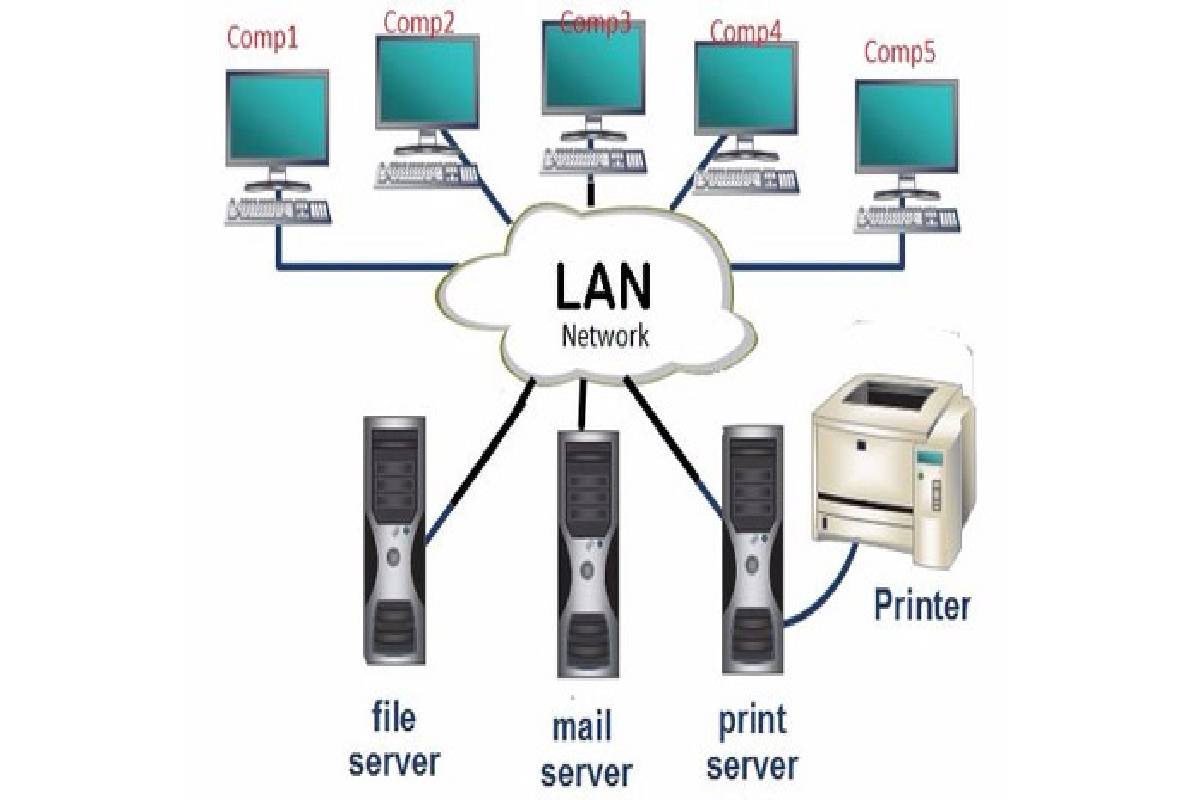Table of Contents
LAN Definition
A local area network (LAN) is a wireless or web connection shared by a group of computers and associated devices.
As a rule, the connected computers share the network-connected devices such as servers or printers within a small geographical area, for example, in an office building.
Larger companies sometimes have a full-fledged data centre in the centre of the LAN.
The servers usually contain applications and data storage that the users share.
However, It may only apply to two or three users, for example, a home network.
Most households now have a network as more and more devices want to connect to the Internet.
The devices include notebooks, tablets, and smartphones connected via a wireless LAN ( WLAN ).
Structure of a LAN
A LAN is limited to about 500 meters and mainly use in home networks or companies.
However, with LAN, one means the complete network of a house or company.
Classifications of LAN
A LAN topology refers to how nodes on a network are connected.
It can refer to the physical arrangement of the devices in a geographic environment or the logical method by which the system configures.
The type of topology in a LAN would determine how data transmit at all times.
Ring topology
- The term “ring” is descriptive of how the nodes are physically linked.
- A ring topology applies a closed-loop cable connecting one device to another, making each device connected to two devices.
- This closed-loop creates a singular flow of data, which means that a message can only travel in one direction.
- Installation is relatively easy, but a reconfiguration of a single network node would require a loop break.
- Because this type of topology has a continuous loop, interference at one stage or node could affect the entire system network.
Star topology
- Its base is on a central hub from which all nodes connect—messages or data pass-through this hub and redirects to the addressed device.
- A point-to-point link establishes from an individual node to and from the central hub to create a single connection.
- It can benefit users by preventing one segment interference from affecting the entire system.
- However, installing this type of network will require individual configuration of these node connections, making your LAN’s initial setup difficult.
Bus topology
- Bus topology relies heavily on a single communication line capable of transmitting data in both directions.
- A central cable, also known as a backbone, connects all nodes on the network.
- In establishing Ethernet, bus topology applies, a standard form of connection in the technology industries.
- And also, It is a commonly used way to configure a LAN because its simple design requires a continuous length of cable that terminates with terminating resistors at each end.
- Installation and reconfiguration of LAN topology is a relatively simple and easy process.
- However, difficulties may be encountered during troubleshooting, as data transmission is dependent on a single cable.
Tree topology
- Integration of technologies applied in the establishment of bus and star topologies form a tree topology.
- The workstations connected to the central hubs linearly support by a single cable that serves as the data transmission’s backbone.
Elements of LAN
LAN may not have a defined range of devices as a boundary for the network.
However, the same components need to create a LAN, regardless of size. The standard features that are required are:
Device connection
- A LAN works to connect devices located within a defined proximity.
- Its connection can only perform this function with the presence of the connecting devices.
- Initially, the computers connect by wired connections.
- However, a wide variety of devices, ranging from desktops, laptops, tablets, and even smartphones, can be connected within the same local network.
- The server’s sharing capabilities can control by the server or by the device itself, depending on its configuration settings.
NIC and drivers
- A network interface card (NIC) enables the connection between the device and the LAN.
- As a means of facilitating network communication, most modern devices have a built-in NIC that allows you to connect to a network.
- Businesses with more specialized needs may choose to provide their devices with a specialized NIC to improve individual computers’ performance within the network.
- however, A driver is a software that also facilitates communication between the device’s operating system and the NIC.
- And also, Like the NIC, the drivers typically builts into the system.
Shared hardware
There are two types of hardware in a LAN based on its use on the network:
Necessary
It includes routers, hubs, and switches that work to connect devices on the network.
And also, These are essential parts of the physical configuration of the LAN since, without these devices, they can establish no connection.
Optional
Network users can share other types of hardware.
Although, It not required, can shared devices such as printers and faxes within a network to create a better working environment.
Network operating system
- To create a LAN, a system must configure to manage the network’s nodes.
- And also, An operating system that provides a network administrator with the ability to check devices on the network, select the resources to share, and also be able to troubleshoot hardware and software on the web.
Connection medium
- Modern LANs can use a wireless WiFi connection or a wired Ethernet cable to connect nodes on a network.
- The use of both methods is also possible. Wireless LANs rely on a WiFi signal that can manage wireless access points from which other devices connect.
- A WiFi signal has a limited range and can protect with a passcode so that only users with permissions can connect to the network.
- And also, Managing an access point is often a function of broadband routers.


